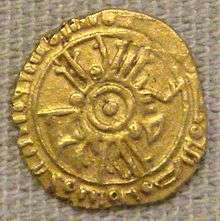Tarì



A tarì (طري lit. "fresh" or "newly minted money" in Arabic)[1] was the Christian designation of a type of gold coin of Islamic origin minted in Sicily, Malta and Southern Italy from about 913 to 1859.
History
In the Islamic world, this type of coin was designated under the name ruba'i, or quarter-dinar, as it weighed 1.05g of gold.[2] The ruba'i had been minted by the Muslims in Sicily, unlike the Muslim rulers of North Africa, who preferred the larger dinar.[3] It became highly popular as it was smaller and therefore more convenient than the large-sized 4.25g dinar.[4]
The tarì were so widespread that imitations were made in southern Italy (Amalfi and Salerno) from the mid-tenth century, which only used illegible "pseudo-Kufic" imitations of Arabic.[5][6][7] When the Normans invaded Sicily in the 12th century, they issued tarì coins bearing legends in Arabic and Latin.[8] Roger II of Sicily issued such coins, becoming the only Western ruler at that time to mint gold coins. Their title was 16 1⁄3 carat, with some adjunction of silver and copper.[9] The tarì were also produced by the Hohenstaufens and the early Angevins.[10]
The tarì coins were generally minted from African gold obtained from Misrata or Tunis in Northern Africa in exchange for grain.[11]
References
Citations
Works cited
- Blanchard, Ian. Mining, Metallurgy and Minting in the Middle Ages. Franz Steiner Verlag, 2001. ISBN 978-3-515-07958-7
- Cardini, Franco. Europe and Islam. Blackwell Publishing, 2001. ISBN 978-0-631-22637-6
- Grierson, Philip. Medieval European Coinage. Cambridge University Press, 1998. ISBN 978-0-521-58231-5
- Matthew, Donald, The Norman kingdom of Sicily Cambridge University Press, 1992 ISBN 978-0-521-26911-7
See also
| Wikimedia Commons has media related to Tarì. |